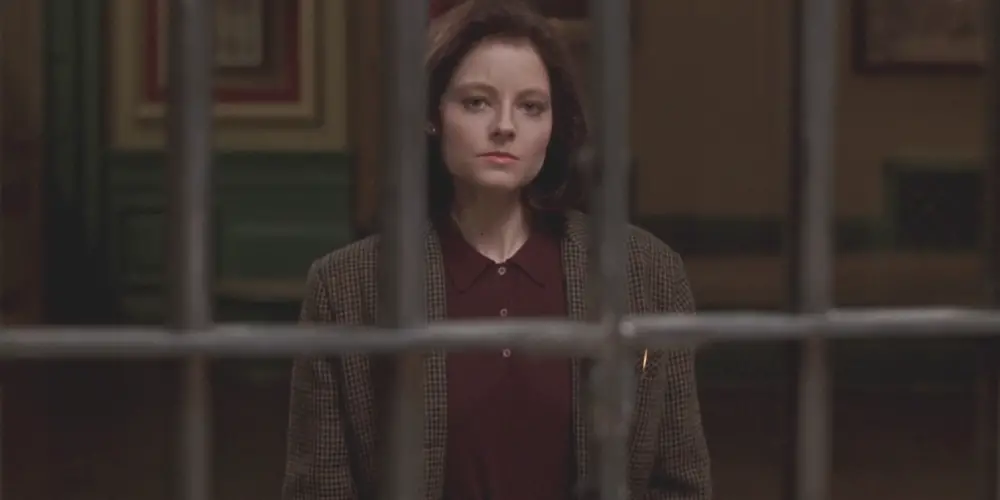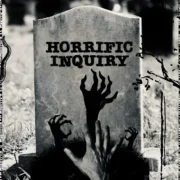Feminine Perspective And Power In THE SILENCE OF THE LAMBS

Chris is a B.A.H. graduate with a concentration in pre-19th…
The Silence of the Lambs is an enduring piece of cinema. Jonathan Demme’s crime-thriller touched a nerve because of its mainstream appeal crossed with glimpses of macabre imagery. A young FBI trainee named Clarice Starling (Jodie Foster) is enlisted by her superior to visit with notorious cannibal Hannibal Lecter (Anthony Hopkins) in prison with hopes of gaining insight into another active serial killer: Jame “Buffalo Bill” Gumb (Ted Levine).
What’s compelling is that the story opts to focus most on the female perspective of Starling. Even though Hopkins won an Oscar in 1991 for his portrayal of Lecter, he and Foster only share four scenes together in total. Levine’s Buffalo Bill, while scary and disturbingly iconic, is a supporting role that ultimately serves as a means to an end for the plot. The one who matters most is the female lead.
Using first person perspective in a sly way, Demme puts the viewer in the literal point of view of FBI Agent Starling. After Clarice’s perspective becomes ours, feminine perspective transforms into a view on feminine power. In a supposed man’s world, she is the one who guides us through the story, as well as the one character able to finally catch the killer of women, Buffalo Bill.
The Camera as Clarice
As soon as Jack Crawford (Scott Glenn) meets Clarice in his office the perspective begins shifting. When Jack speaks he’s looking directly into the camera. When Clarice responds she speaks looking off centre. This technique allows us to feel like we’re seeing things from her perspective.

The first time we meet Hannibal, the camera pans over to reveal Hopkins eerily staring directly into the lens. It feel as if he’s aware of everything. Furthermore, the viewer feels anchored to Clarice’s point of view now, and most of this technique overall is used during scenes between Lecter and Starling.
Demme finds various other scenes allowing the viewer to experience the film through Clarice’s eyes. For instance, when Crawford takes Starling to investigate another Buffalo Bill killing, she finds herself in a room of all male officers: the camera pans around, every man staring at Clarice, as shots of her awkwardly standing in the middle are intercut now and then. Not only is the film told from a feminine perspective, the usual crime-thriller formula is subverted to show us the power of a lone woman amongst a sea of men.
A Strong Woman in the Midst of Men with Power
Being an FBI agent often inherently requires Clarice to exploit her femininity. She has no choice. Such as when she deals with Dr. Frederick Chilton (Anthony Heald), whose fragile ego requires the stroke of a woman’s compliments; all in order for Clarice to talk with Lecter on her terms.
Even with Hannibal, their relationship is prefaced by the fact she is female. First of all, Crawford sends her there initially due to the fact she is a woman. Later, an inmate named Miggs makes sexual comments about Clarice and throws ejaculate in her face. This disgustingly misogynistic gesture precipitates Lecter giving her more information; an event that wouldn’t have happened were Starling a man. Once Clarice figures out that Crawford originally sent her due to gender, she becomes more aware of her power.

Strangely enough, the one person who does not treat Starling’s femininity negatively is in fact Lecter. On the one hand, Crawford treats her as decidedly ‘other’ in the way he tries protecting her from crime details he feels might offend her feminine sensibilities. On the other hand, Lecter treats any offense to her femininity with disdain such as convincing Miggs to swallow his tongue, and he doesn’t shy away from discussing any nasty details of Buffalo Bill’s crimes with her. The way in which Hannibal allows her womanhood to operate normally as it should also enables her to finally enact that power to catch Bill.
Men, Men, Everywhere, Yet None Can Solve the Crime
It isn’t only Clarice whose expertise helps catch Buffalo Bill. Her roommate and fellow FBI trainee Ardelia Mapp (Kasi Lemmons) is part of the solution. Together, the two women try to figure out the last of Lecter’s clues. Crawford and the FBI are on a diverging path, but Clarice and Ardelia refuse to give up. This puts Starling directly in the path of Bill.
When Clarice ends up at Bill’s home, alone without backup, she is forced to either fight or die. Consistently proving she is capable, Clarice not only survives, she kills Bill using instinct and her training from the FBI. Essentially, femininity got Clarice to where she was in various ways. What paved the way to her triumph is the fact she proved a woman is as capable of police work as a man; her female identity did not pull the trigger, she did.

In an ironic twist, Clarice kills Bill, a man who wants to be a woman. By killing him she denies his womanhood: he is not actually transgender, but rather a man who hates women because of his inability to successfully become one. Moreover, this act is the film’s affirmation of Clarice and her feminine power.
Paving the Way
The expected route for most typical crime-thrillers to take, especially one concerning male serial killers, is one springing from the male perspective. The Silence of the Lambs subverts expectations by telling the story through the eyes of Clarice Starling. Not only does the viewer see the film from her point of view, Clarice is the saviour of the plot, as she takes down the woman killer, Buffalo Bill. Director Jonathan Demme takes us on a path from feminine perspective into a powerful depiction of how women are as worthy of hero status as any male character.
It’s no coincidence that a landslide of new, strong lead female characters sprang up after 1991. Clarice led the way for FBI Special Agent Dana Scully of The X-Files, New York Detective Olivia Benson on Law & Order: Special Victims Unit, among many others. The Silence of the Lambs is often remembered fondly as one of the more unsettling mainstream horror movies in cinematic history. It should also be regarded as the crime-thriller which helped change our perception of women in the genre.
Even 25 years on, filmmakers still struggle to define women and their womanhood on film and television. Just one of the reasons The Silence of the Lambs is worth revisiting in a different light than simply acting as a Hannibal Lecter movie.
Are there any other earlier examples before Clarice Starling of powerful women breaking through in male dominated police films? Or a film before The Silence of the Lambs which presents the female perspective in law enforcement as vividly?
Does content like this matter to you?
Become a Member and support film journalism. Unlock access to all of Film Inquiry`s great articles. Join a community of like-minded readers who are passionate about cinema - get access to our private members Network, give back to independent filmmakers, and more.
Chris is a B.A.H. graduate with a concentration in pre-19th century literature from Memorial University of Newfoundland. His short stories have been published in The Cuffer Anthology Volumes VI & VII, as well as upcoming stories in new anthologies from Centum Press (One Hundred Voices & One Hundred Voices Pt. II) and Science Fiction Reader. A short screenplay of his titled "New Woman" is currently being produced, to be shot in 2017; it is a female-led dramatic horror, a period piece set in 1888.












